Granny’s Bread and Butter Pickles Recipe
This post may contain affiliate links, which means that I may receive a commission if you make a purchase using these links. As an Amazon Associate I earn from qualifying purchases.
These old-fashioned bread and butter pickles have a crisp texture and a balanced sweet and sour flavor. The slightly sweet tangy flavor makes them perfect for topping your favorite burgers and sandwiches.
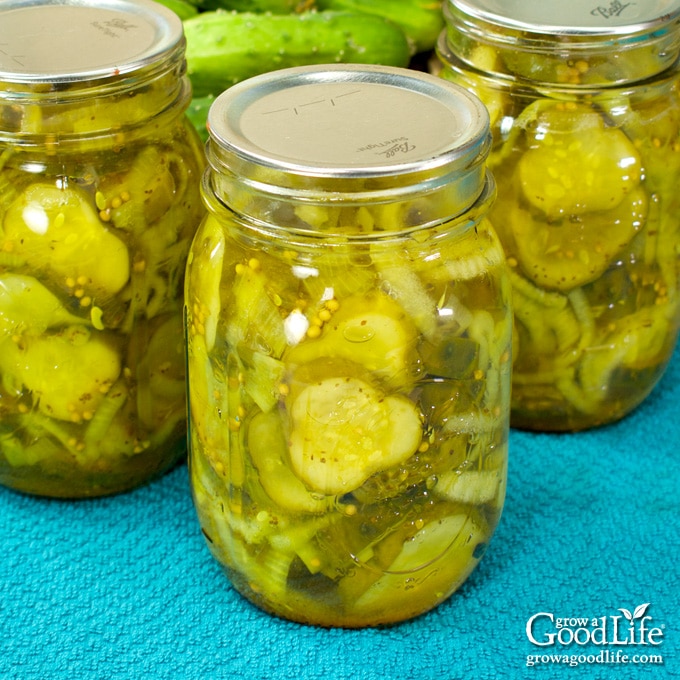
“I love pickles!” my husband said as I planned the garden soon after moving to our property.
With this in mind, I planned on growing a bunch of pickling cucumbers. I was not a fan of pickles, so normally I grew only a few cucumber plants to eat fresh and in salads. However, this was the year I acquired a lot of canning jars, and I was determined to fill each one with garden grown goodness.
Cucumbers ended up exceeding my expectations that year and were my most prolific producers. I barely kept up with processing them into endless batches of pickles. I made bread and butter pickles, kosher dill pickle spears and sweet pickle relish from the Ball Blue Book Guide to Preserving.
Soon my shelves were filled with jars and jars of pickles. We had so many pickles that I began asking my husband if he wanted pickles with almost meal. I gave jars of pickles and relish away and still had shelves full years later.
Thankfully, I learned my lesson and now only plant just a few cucumber plants to provide enough for fresh eating and a few batches of canned pickles and relish.
I have never been a big fan of pickles until I tried this recipe from a dear friend who was like a Granny to many. I call this recipe Granny’s Bread and Butter Pickles in her honor.
Tips for Canning Bread & Butter Pickles
These old-fashioned bread and butter pickles are made from cucumbers, onions and pickling spices. They are tangy, sweet, and crunchy—a perfect addition to any sandwich, hamburger, or hot dog. Here are tips for home canning bread and butter pickles:
Select crisp, freshly harvested pickling cucumbers
Pickling cucumbers are short, thin skinned cucumbers that are primarily used for processing or pickling. Skip the waxed cucumbers at the grocery store. The wax prevents the pickling liquid from penetrating the cucumber.
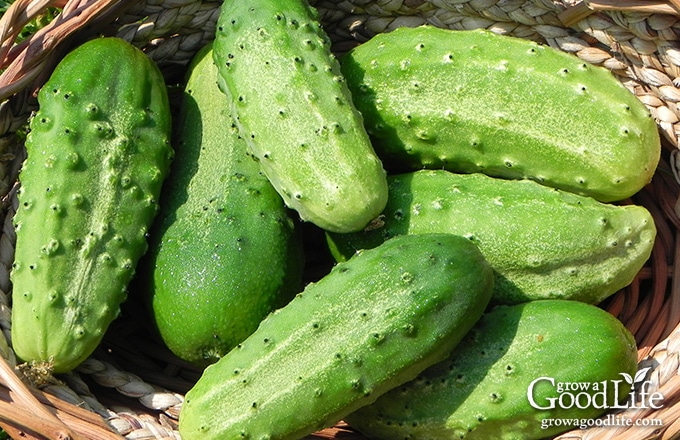
Use pickling salt
Table salt contains iodine and anti-caking agents that can darken pickles and cause cloudiness in your jars. Instead, use pickling salt, which is also called canning salt.
Use commercial vinegar with at least 5% acidity
- Apple cider vinegar is made from fermented apples. It will darken your pickles slightly, but adds a nice flavor.
- White vinegar is clear vinegar made by distilling corn and rye. Choose an organic brand to avoid genetically modified corn.
Steps for Canning Pickles
If you are new to canning or haven’t canned in a while, it may be helpful to review this article on water bath canning at the National Center for Home Food Preservation website.
A more detailed and printable recipe can be found at the bottom of this article, but these are the general steps for making and canning bread and butter pickles:
Step 1: Gather your canning equipment
- Water bath canner with canning rack
- 5 pint sized canning jars
- Lids and bands (new lids for each jar, bands can be reused)
- Canning tools: jar lifter, canning ladle, funnel, and bubble popper
- Plus basic kitchen supplies such as a large sauce pot, large bowl, small pot, towels, knife, and a cutting board
Step 2: Prepare your cucumbers and onions
Wash cucumbers well under running water and cut into 1/4-inch slices discarding ends. Peel onion and slice thinly.
Combine the cucumber and onions a large bowl. Scatter the canning salt over the top, cover with the ice and water, and let stand for about 3 hours.
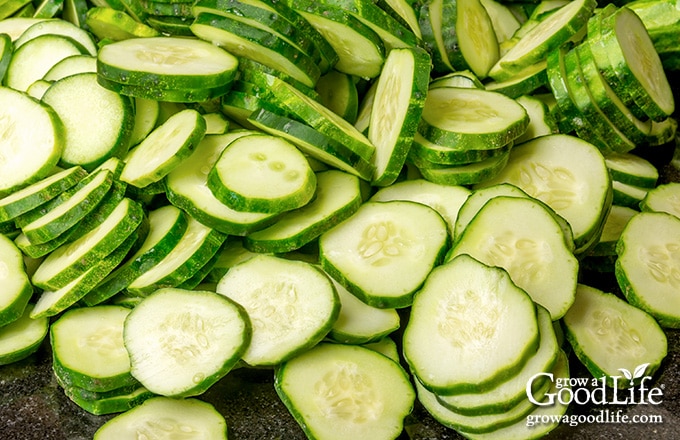
Step 3: Prepare your canning equipment
Wash your jars, lids, bands, and canning tools in warm, soapy water. Rinse well, and set the lids, bands, and tools aside to air dry until you are ready to use them.
Setup your water bath canner with the canning rack on a large burner of your stove. Place the jars upright in the canner, and add water to cover. Bring the canner to a simmer (180˚F) for 10 minutes, and keep the jars hot until you are ready to fill them.
Step 4: Make the pickling brine
In a large pot, combine sugar, mustard seed, celery seed, ground turmeric, peppercorns, and vinegar. Heat just to a boil.
Drain and rinse the cucumbers and onions under fresh water. Add the drained cucumber and onion slices to the pot of pickling brine and return to boil. Reduce heat and keep warm as you fill your jars.
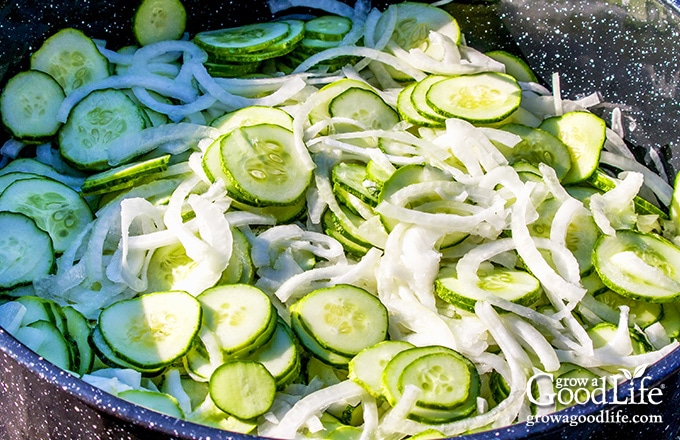
Step 5: Can the pickles
Lay a kitchen towel on the counter. Use the jar lifter to remove a hot jar from the canner, drain, and place on the towel. Keep the remaining jars in the canner, so they stay warm.
Place the canning funnel on the jar, and add the warm pickles and brine to the jar, leaving 1/2-inch headspace. Run the bubble popper through the jar to release any trapped air bubbles. Make sure all the pickles are submerged under the brine. Remove any that stick out, and adjust the headspace again if needed.
Wipe the rim with a damp towel to remove residue. Center a lid on the jar, place the band over the lid, and screw it on until fingertip tight. Place the jar back into the canner, and repeat with the rest of the jars.
Adjust the water level so it is covering the jars by several inches, bring the pot to a boil, and process the jars for the times indicated in the recipe below.
Let the jars cool, test the seals, label and date the jars, and store the canned pickles in a cool, dark location. Let the pickles stand for about 4 weeks to develop flavor.
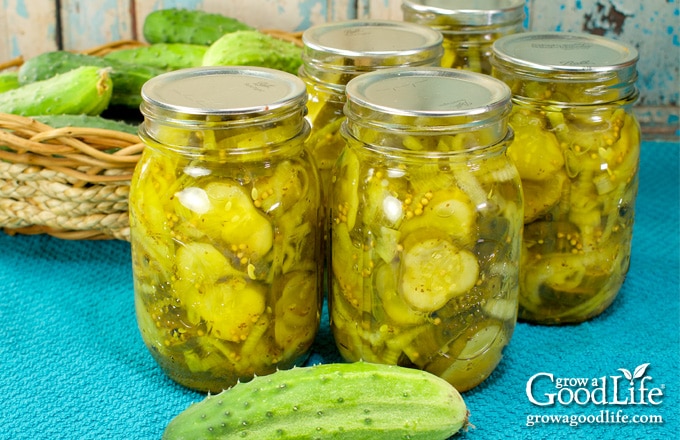
Granny's Bread and Butter Pickles Recipe
Ingredients
- 3 pounds pickling cucumbers
- 1 pound onions
- 1/4 cup canning or pickling salt
- 2 quarts crushed ice or ice cubes and water
- 1 cup sugar
- 1 tablespoon yellow mustard seed
- 1 teaspoon celery seed
- 1 teaspoon ground turmeric
- 1/2 teaspoon black peppercorn
- 3 cups apple cider vinegar 5% acidity (or white vinegar)
Instructions
Prepare your cucumbers and onions:
- Wash cucumbers, cut into 1/4-inch slices discarding ends. Peel and thinly slice onions. Combine sliced cucumber and onions a large bowl.
- Sprinkle canning salt over the top of the cucumbers and onions, cover with ice and water, and let stand for 3 hours.
Prepare your canning equipment:
- Wash your jars, lids, screw bands, and canning tools in hot soapy water. Rinse thoroughly to remove all suds. Set aside to air dry on a clean kitchen towel.
- Place the jar rack into water bath canner, place jars in the canner, and add water to cover. Bring the canner to a simmer (180˚F) for 10 minutes, and keep the jars hot.
Make your bread and butter pickles
- In a large pot, combine sugar, mustard seed, celery seed, ground turmeric, peppercorns, and vinegar. Heat just to a boil.
- Drain and rinse the cucumber and onions under fresh water. Add the drained cucumber and onion slices to the large pot and return to boil. Reduce heat and keep warm as you fill your jars.
Can your bread and butter pickles
- Spread a kitchen towel on the counter. Use the jar lifter to remove a hot jar from the canner, drain, and place on the towel. Keep the remaining jars in the canner, so they stay warm.
- Use your canning funnel and ladle to pack the hot cucumbers and onions loosely into the jar. Ladle the hot brine over the pickles, and maintaining a 1/2 inch headspace.
- Run the bubble popper through the jar to release any trapped air bubbles. Make sure all the pickles are submerged under the brine. Remove any that stick out, and adjust the headspace again if needed.
- Wipe the rim to remove any residue, center a lid on the jar, and screw on a band until it is fingertip tight. Use your jar lifter to place the jar back into the canner, and repeat with the remaining jars.
- Once all the jars are in canner, adjust the water level so it is 2 inches above the jar tops.
- Cover the canner and bring to boil over high heat. Once water boils vigorously, continue boiling and process pickles for 10 minutes at altitudes of less than 1,000 feet. Adjust processing time for your altitude if necessary (See Note).
- When processing time is complete, turn off heat, remove the cover, and allow the canner to cool down and settle for about 5 minutes.
- Spread a dry kitchen towel on the counter. Remove the cover by tilting lid away from you so that steam does not burn your face.
- Use the jar lifter to remove the jars from canner and place on the towel. Keep the jars upright, and don't tighten bands or check the seals yet. Let the jars sit undisturbed for 12 to 24-hours to cool.
- After 12 to 24-hours, check to be sure jar lids have sealed by pushing on the center of the lid. The lid should not pop up. If the lid flexes up and down, it did not seal. Refrigerate jar and use up within a week.
- Remove the screw on bands and wash the jars. Label and date the jars. Store in a cool, dark location. Allow 4-5 weeks for the pickles to develop their flavor. Use within a year. Yields about 5 pints depending on the size of your cucumbers.
Notes
Nutrition
This recipe was originally published July 5, 2015. It has been reviewed and updated with additional information and new photos.
If you know someone who doesn’t like pickles, let them taste these pickles. Granny’s Bread & Butter Pickles are so sweet that it may just convert them into a pickle lover too.
Canning Resources:
- USDA Complete Guide to Home Canning
- Ball Blue Book Guide to Preserving
- Storing Home Canned Goods – National Center for Home Preservation
- Causes and Possible Solutions for Problems with Canned Foods – National Center for Home Preservation
You May Also Like These Canning Recipes:
- Spiced Apple Jelly Recipe with No Added Pectin
- How to Can Carrots for Food Storage
- Homemade Applesauce for Canning
- Crabapple Jelly with No Added Pectin
- Seasoned Tomato Sauce for Home Canning
Good planning is key to a successful vegetable garden
Whether you are new to growing your own food or have been growing a vegetable garden for years, you will benefit from some planning each year. You will find everything you need to organize and plan your vegetable garden in my PDF eBook, Grow a Good Life Guide to Planning Your Vegetable Garden.

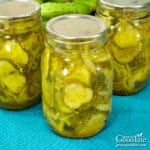

Hi, I made a batch and they came out mushy. Would that happen from over cooking them?
Kevin, There are so many reasons pickles come out mushy. Did you follow the recipe? Did you use young, fresh pickling cucumbers? Did you trim off the blossom ends? Here are some other pickle problems and solutions to help you troubleshoot. Mushy pickles are a bummer, but you can chop and use them to flavor tuna salad, or use like relish to top sandwiches and burgers.
I want to use quart jars (big family)
So is this possible? How is the processing
Any different
Karen, I checked the Ball Blue Book Guide to Preserving and the processing time for quart sized jars of pickles is 15 minutes.
In your reply to Rachel, you said that you returned to the original volume of vinegar to four cups. This recipe calls for just 3 cups of vinegar. Which should use? I have mixed the ingredients, sterilized the jars and waiting for the brine time to finish.
Mary, Please follow the recipe as written. I tested it extensively last year and made sure it is correct. There may be a little brine leftover depending on the size of your cucumber and onion pieces.
How long will the pickles last once canned.
Donna, About a year if stored in a cool, dark location.
Hi! Does this recipe need to be canned, or can I skip the canning and refridgerate them instead? Thanks!
Yes, you can refrigerate the pickles instead of canning them, but you will need to use them up within several months. If you are looking for a smaller batch, check out this article for making refrigerator pickles with any vegetables.
Does the color of onion matter? Just curious as I know some are sweeter than others.
Emily, You can use any type of onion such as yellow, white, or red onions. Please keep in mind that red onions will stain everything pink. 🙂
is processing time from when it boils or when you submerge them?
Mary, Always begin processing time once the pot boils vigorously. I shared a link in the article above to the National Center for Home Preservation that explains in more detail how to use a boiling water canner that you may find helpful: Using Boiling Water Canners. Please let me know if you have any questions.
This is an excellent recipe. I think the moral of the story here is you can add, remove, alter ingredients to one’s flavor palette/liking but the key is the MAIN ingredients like sugar, vinegar, cucumbers, onions. I’ve got a recipe that I have used and this is exactly the same. I think most are, it’s just what I said… Add some red pepper flakes for some heat, or add some more peppercorn for more heat, etc…. Nice job, it’s really good and easy to follow.
Tony, Yes, it is the vinegar that preserves the cucumbers and makes it safe for home canning, You can adjust the pickling seasoning, the amount of sugar, and the type of vinegar used.
Hi Rachel, I tried this recipe, fancied up the spices and added hot pepper, but followed the quantities of everything else. I did fill 5 pint jars exactly, but had a whole cup of brine left over. I read some of the old comments and noticed at some point that you changed the recipe to increase the amount of brine because some people didn’t have enough. Do you recall how much vinegar you used in the original recipe? Just curious to know how far off I was. Thanks for the recipe, and I hope you are well. –Janet
Hi Janet! I have tested this recipe extensively over this last summer and the amount of brine needed is different every time depending on the size of the vegetables and how tightly the jars are packed. At first, I increased the amount of the brine because I thought it is better to have too much, rather than too little. Later after testing, I returned the amount of vinegar to the original 3 cups and reduced the onions from 2 pounds to 1 pound.
Hi! I am fairly new to Canning and my first session was bread and butter pickles. I added the onions and turmeric, like here. Can I leave out the onions and turmeric next time? Love to try your recipe, and I just want pickles this time. Thank you!
Kate, Yes, you can leave out the onions and turmeric.
Thank you!
I just made my second batch with your recipe. I left out the onions, but stuck to the recipe exactly. I used English cucumbers the first time, and this batch is a few varieties I picked up at my farmers market. The brine is so flavorful and my pickles turned out fantastic! Thanks for an awesome recipe!